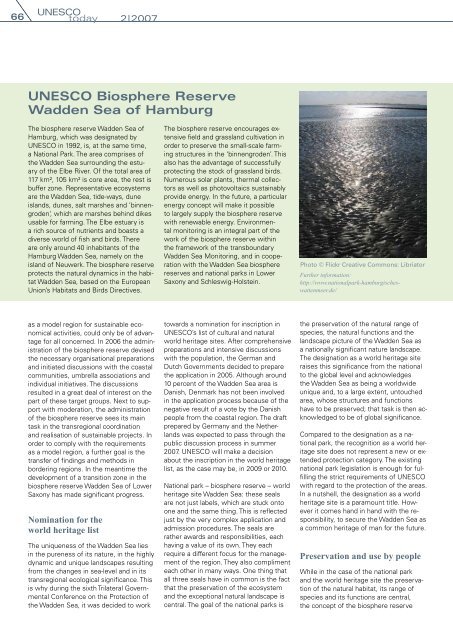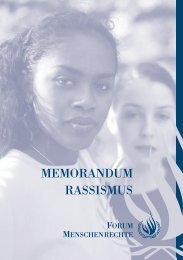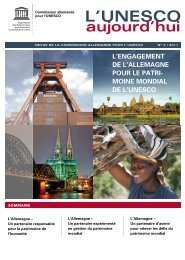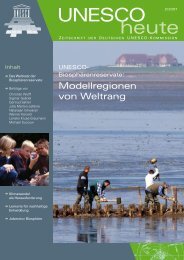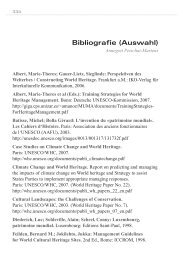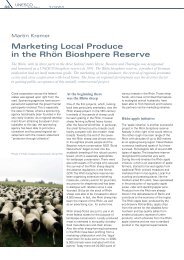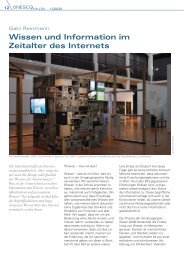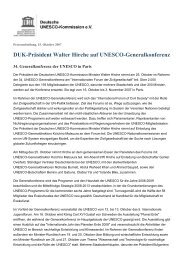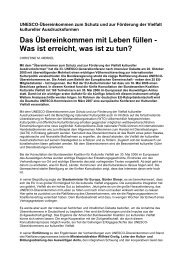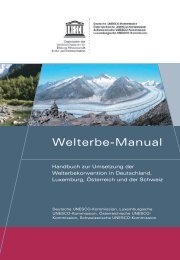Biosphere Reserves - UNESCO Deutschland
Biosphere Reserves - UNESCO Deutschland
Biosphere Reserves - UNESCO Deutschland
You also want an ePaper? Increase the reach of your titles
YUMPU automatically turns print PDFs into web optimized ePapers that Google loves.
<strong>UNESCO</strong><br />
today 2|2007<br />
<strong>UNESCO</strong> <strong>Biosphere</strong> Reserve<br />
Wadden Sea of Hamburg<br />
The biosphere reserve Wadden Sea of<br />
Hamburg, which was designated by<br />
<strong>UNESCO</strong> in 1992, is, at the same time,<br />
a National Park. The area comprises of<br />
the Wadden Sea surrounding the estuary<br />
of the Elbe River. Of the total area of<br />
117 km², 105 km² is core area, the rest is<br />
buffer zone. Representative ecosystems<br />
are the Wadden Sea, tide-ways, dune<br />
islands, dunes, salt marshes and ’binnengroden‘,<br />
which are marshes behind dikes<br />
usable for farming. The Elbe estuary is<br />
a rich source of nutrients and boasts a<br />
diverse world of fish and birds. There<br />
are only around 40 inhabitants of the<br />
Hamburg Wadden Sea, namely on the<br />
island of Neuwerk. The biosphere reserve<br />
protects the natural dynamics in the habitat<br />
Wadden Sea, based on the European<br />
Union’s Habitats and Birds Directives.<br />
as a model region for sustainable economical<br />
activities, could only be of advantage<br />
for all concerned. In 2006 the administration<br />
of the biosphere reserve devised<br />
the necessary organisational preparations<br />
and initiated discussions with the coastal<br />
communities, umbrella associations and<br />
individual initiatives. The discussions<br />
resulted in a great deal of interest on the<br />
part of these target groups. Next to support<br />
with moderation, the administration<br />
of the biosphere reserve sees its main<br />
task in the transregional coordination<br />
and realisation of sustainable projects. In<br />
order to comply with the requirements<br />
as a model region, a further goal is the<br />
transfer of findings and methods in<br />
bordering regions. In the meantime the<br />
development of a transition zone in the<br />
biosphere reserve Wadden Sea of Lower<br />
Saxony has made significant progress.<br />
Nomination for the<br />
world heritage list<br />
The uniqueness of the Wadden Sea lies<br />
in the pureness of its nature, in the highly<br />
dynamic and unique landscapes resulting<br />
from the changes in sea-level and in its<br />
transregional ecological significance. This<br />
is why during the sixth Trilateral Governmental<br />
Conference on the Protection of<br />
the Wadden Sea, it was decided to work<br />
The biosphere reserve encourages extensive<br />
field and grassland cultivation in<br />
order to preserve the small-scale farming<br />
structures in the ‘binnengroden’. This<br />
also has the advantage of successfully<br />
protecting the stock of grassland birds.<br />
Numerous solar plants, thermal collectors<br />
as well as photovoltaics sustainably<br />
provide energy. In the future, a particular<br />
energy concept will make it possible<br />
to largely supply the biosphere reserve<br />
with renewable energy. Environmental<br />
monitoring is an integral part of the<br />
work of the biosphere reserve within<br />
the framework of the transboundary<br />
Wadden Sea Monitoring, and in cooperation<br />
with the Wadden Sea biosphere<br />
reserves and national parks in Lower<br />
Saxony and Schleswig-Holstein.<br />
towards a nomination for inscription in<br />
<strong>UNESCO</strong>’s list of cultural and natural<br />
world heritage sites. After comprehensive<br />
preparations and intensive discussions<br />
with the population, the German and<br />
Dutch Governments decided to prepare<br />
the application in 2005. Although around<br />
10 percent of the Wadden Sea area is<br />
Danish, Denmark has not been involved<br />
in the application process because of the<br />
negative result of a vote by the Danish<br />
people from the coastal region. The draft<br />
prepared by Germany and the Netherlands<br />
was expected to pass through the<br />
public discussion process in summer<br />
2007. <strong>UNESCO</strong> will make a decision<br />
about the inscription in the world heritage<br />
list, as the case may be, in 2009 or 2010.<br />
National park – biosphere reserve – world<br />
heritage site Wadden Sea: these seals<br />
are not just labels, which are stuck onto<br />
one and the same thing. This is reflected<br />
just by the very complex application and<br />
admission procedures. The seals are<br />
rather awards and responsibilities, each<br />
having a value of its own. They each<br />
require a different focus for the management<br />
of the region. They also compliment<br />
each other in many ways. One thing that<br />
all three seals have in common is the fact<br />
that the preservation of the ecosystem<br />
and the exceptional natural landscape is<br />
central. The goal of the national parks is<br />
Photo © flickr Creative Commons: Libriator<br />
Further information:<br />
http://www.nationalpark-hamburgischeswattenmeer.de/<br />
the preservation of the natural range of<br />
species, the natural functions and the<br />
landscape picture of the Wadden Sea as<br />
a nationally significant nature landscape.<br />
The designation as a world heritage site<br />
raises this significance from the national<br />
to the global level and acknowledges<br />
the Wadden Sea as being a worldwide<br />
unique and, to a large extent, untouched<br />
area, whose structures and functions<br />
have to be preserved; that task is then acknowledged<br />
to be of global significance.<br />
Compared to the designation as a national<br />
park, the recognition as a world heritage<br />
site does not represent a new or extended<br />
protection category. The existing<br />
national park legislation is enough for fulfilling<br />
the strict requirements of <strong>UNESCO</strong><br />
with regard to the protection of the areas.<br />
In a nutshell, the designation as a world<br />
heritage site is a paramount title. However<br />
it comes hand in hand with the responsibility,<br />
to secure the Wadden Sea as<br />
a common heritage of man for the future.<br />
Preservation and use by people<br />
While in the case of the national park<br />
and the world heritage site the preservation<br />
of the natural habitat, its range of<br />
species and its functions are central,<br />
the concept of the biosphere reserve


